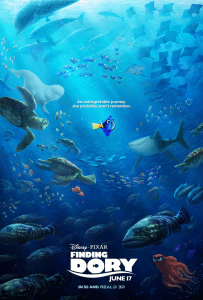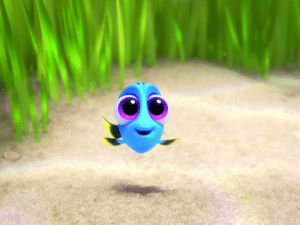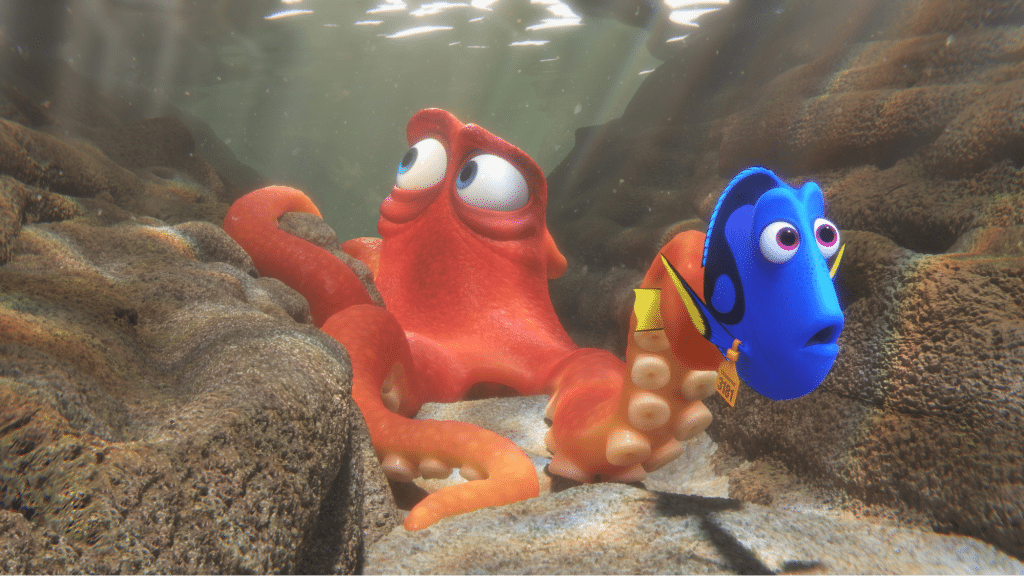Full Disclosure: There was literally no way I would render a bad review of Finding Dory. Here is a picture of me about to lose control of myself at the Seattle Aquarium.
If you are looking for an unbiased opinion about sea creatures or animated movies that depict them, you are in the wrong place.
That being said…
 Finding Dory
Finding Dory
Directors: Andrew Stanton and Angus McLane
Writers: Andew Stanton, Angust McLane, Victoria Strouse, Bob Peterson
Starring: Ellen DeGeneres, Albert Brooks, Ed O’Neill
Disney Pixar
June 17, 2016
Finding Dory continues a lengthy Pixar tradition of making me cry in public. It may be impossible to examine it without the context of the original, Finding Nemo (2003). But by shifting focus to Dory, the Pixar creative team has released a wonderful, action-packed, and deeply sympathetic story that helps frame developmental disabilities in a way that children can understand. Spoilers ahead!

We open on the last memories of Dory as a baby fish, struggling to remind herself of basic survival skills (with helpful guidance and mnemonics from her parents, Jenny and Charlie.) But she also has a craving to swim with other fish, and the urge to explore the wider ocean becomes a self-fulfilling prophecy: Dory finds herself alone and unable to remember the basic details about her home. Some of the fish she meets are sympathetic, and some are impassive, but none of them have the skills or energy to help Dory find her parents.
One year later, after the events of Finding Nemo, a series of flashbacks inspires Dory to return to the aquarium/conservation center where she grew up (a delightful homage to the Monterey Bay Aquarium). Anyone who’s seen a Pixar movie knows the drill: there’s a series of amazing chases and obstacle courses, which only brave and determined heroes can overcome. There’s not a few red herrings (haha) that guide our hero back to her starting point, only to find that her parents aren’t in the aquarium at all.
The middle act is the weakest of the movie. Finding Dory’s cast focuses on a loveable band of misfits: Becky, a bug-eyed loon who gets her head trapped in a bucket; Hank, the octopus who wants the comfort of aquarium life, Destiny, a myopic whale shark; and Bailey, a beluga who can’t echolocate. Dory’s interactions with these characters (and their shared supportive natures) are characterized by a mode of sweetness that voice actress Ellen DeGeneres captures perfectly. But Dory’s joy is punctuated with scornful commentary from Marlin, the clownfish main character of Finding Nemo.
In fact, the cast’s efforts to find Dory’s friends are constantly stymied by Marlin’s unwillingness trust in Dory and her new associates. The final message—that your family encompasses your entire supportive community—is tinged with bitterness, since Marlin is so often ignorant of Dory’s specific needs, or too busy to accommodate them.
Dory herself has been promoted from comic relief sidekick to heroine. Gags from the earlier film have been expanded, and Dory’s developmental differences feel very real. “Just keep swimming,” for instance, was a goofy song in Nemo; Finding Dory turns it into a mantra that eases Dory away from panic attacks. Dory’s inability to read the word “escape” translates between movies; while she is able to read, her interpretation of the words depends on other fishes’ contextual clues.
The best parts of the movie are interactions between Dory and her surly octopus guide through the aquarium complex. With her literacy and Hank’s camouflage and mobility (also, the soothing narrative voice of Sigourney Weaver, the pre-recorded aquarium guide), they move between ocean zones and develop empathy for each other. Hank, for instance, freezes in terror as he’s poked aggressively in the children’s touching pool. Despite the fact that Dory got them into the pool, Hank still credits her with rescuing him—a far cry from Marlin’s exasperated accusations in the first movie.
The precise point where I started crying sees Dory alone again, with Hank, Marlin, and Nemo trapped aboard a transport truck en route to Cleveland. These first-person shots are dizzying, as Dory frantically searches for anything to anchor her to her limited memories, fixating on a symbol that’s by all means very common in the ocean: a seashell. But even as Dory follows the trail of shells back to her parents, she spends the remainder of the movie believing in herself and rescuing the other wayward members of her family—her support network. Her insistence on recollecting her family shows the stark difference between her experience and Nemo’s, who asks earlier, “Will we never see Dory again?”
Nemo’s was a story about independence, and allowing people to try and fail. I much prefer the message of Finding Dory: a strong, supportive community helps fill in our individual weaknesses, and perceived weaknesses shouldn’t exclude individuals from a community.
Don’t let this complaint dissuade you from seeing a very sweet movie, with a ton of other stuff that I didn’t mention but loved: otter cuddle time, sea lions voiced by the guys from The Wire, adorable crabs, and I can’t overstate the importance of Sigourney Weaver. On top of a sweet story, I’d also be remiss if I failed to mention that Finding Dory is a technical marvel. So let’s close on this video published by CNET, on the complexity of animating Hank the octopus, true hero of Finding Dory:




